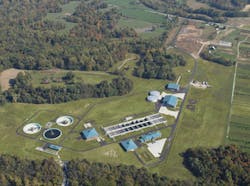| Aerial view of Kentucky's Sanitation District No. 1. Photo courtesy of Walt Roycraft Photography and GRW Engineers. |
In 2009, SD1 first entered the world of ERM with the construction of an eletronic records repository inside the Laserfiche system it purchased for what was then considered to be a pilot project. Another $20,000 was allocated to scan current and recently archived records into that repository, and within a few weeks, staff started instantly accessing records from their computers that they previously had to pull from folders in metal filing cabinets. What used to take hours was taking minutes, and the pilot project was soon expanded to include historic documents, budgets and personnel files, among other records.
While the new technology was a game changer for many staff, overall operations still struggled to keep pace with the utility's relentless expansion in one of the fastest growing regions in the Midwest -- northern Kentucky. Located across the Ohio River from Cincinatti, SD1 grew to become the second largest wastewater district in the state with 1,700 miles of sewer lines and 142 pumping stations, sanitizing 30 million gallons of wastewater discharged daily by 100,000 homes and businesses in 31 cities and towns.
Along with a 40-percent population increase in its service area, SD1 was dealing with rapidly expanding and increasingly stringent regulatory oversight. By late 2008, the utility was drowning in its own paperwork. Current records were managed by the page in manila folders stored alphabetically in filing cabinets. Archives were exported by the truckload to offsite facilities, where exposure to poor conditions once resulted in having to destroy six tons of records. Such adversities prompted SD1's decision to investigate and invest in electronic records technology and start building the utility's first repository.
At the same time, ever-increasing regulatory requirements meant that every department at SD1 was expected to be able to provide any page of documentation -- current or archived -- that was requested by a growing number of inspectors, attorneys or customers. Failure to do so could result in a penalty: The utility was once fined $40,000 for its inability to produce eight pieces of email.
With new state government transparency laws looming and a rapidly expanding population needing service, Jenisch came to realize that meeting the utility's ever-expanding records management needs demanded hiring more clerical staff or investigating and investing in ERM technology.
"It was a daily grind just to get the work done," she said. "In the old days, we could get away with pulling file folders from archives and hand-searching for records. In 2012, that was no longer an option."
In 2013, Jenisch decided to expand the Laserfiche system to include a suite of software products called RIO that would propel SD1 into a new realm of ERM called enterprise content management (ECM). Instead of merely turning paper records into electronic images for increased ease of access, ECM uses software to build computerized workflows that move and manipulate those digitized documents throughout an organization. Further, ECM turns the manual passing of paperwork from person to person into the computerized flow of information from decision-maker to decision-maker.
Jenisch started SD1's ECM buildout in various department, eventually moving to the HR department where many employee records required paper-heavy processes that previously entailed sending emails back and forth. Most of those processes have now been automated through an electronic HR employee matrix, which is automatically updated with any new hires or changes in employee status. Processing employees' travel requests, cash advances and expense reports has also been similarly automated.
The success in HR prompted Jenisch to expand the system to other possible departments, which, she soon learned, meant every department. Automated workflows now route 75 invoices per day for approval and payment in Accounts Payable, reducing processing time from three to four weeks to under two weeks and eliminating the need for four file drawers of on-site storage space per year.
Stormwater inspection reports are now automatically ushered past the required desks in SD1, out to independent contractors if need be, and eventually to Accounts Payable and archiving.
These and many other electronic workflows constructed with RIO software allow SD1 to leverage its growing electronic records repository into a records managment tool much more powerful than an electronic filing cabinet, Jenisch explained. Time-consuming and repetitive manual processes like photocopying, emailing, faxing, and snail-mailing have been automated, saving hundreds of staff hours per month.
"Not only is more work getting done much more quickly but it is getting done with greater accuracy and reliability," Jenisch said. "Taking the human element out of these repetitive tasks wherever possible means reducing the opportunities for making mistakes."
As ECM is rolled out to other departments, the need to integrate it with other computer records management systems in those departments has become central to creating a truly enterprise-wide content management system. One such integration was with the utility's accounting software system, Great Plains, eliminated dozens of staff hours spent each week manually inputting pages of accounting records into the records repository.
As workflows and integrations continue across all of SD1's departments, Jenisch is utilizing another software system to remove one of the last -- and arguably the most stubborn -- vestiges of paperwork within the utility: the form. Dozens of them are used throughout the various departments and, because these forms are the source point for so much record keeping and information processing, the entire organization is heavily dependent on them.
Jenisch started with the employee travel request form, then moved on to the cash advance and expense report forms. Employees planning to file any of these three requests can now access the form on their computers, where they are filled out and automatically routed through approval and into archiving.
"The entire process is now done electronically," Jenisch said. "From the initial request to the payments and receipts handled by accounting, it's so clean and simple."
More challenging, however, is the training required to enable SD1 office staff to be proficient with the ECM technology, explained Jenisch. Laserfiche resellers Paper-Lite, a division of Florida-based MCCi, conducts initial training and follow-up visits as requested by SD1. But internal training sessions and a general push to keep staff not just proficient but also engaged in the technology is vital to the overall success of any agency's deployment of ECM.
"A lot of these systems and workflows can get very customized," Paper-Lite Vice President Nancy Mathes said. "If you don't use this technology, you risk losing the ability to do so. So it's important to push staff to not just use the software but find new ways to use it. Being innovative and engaged is the surest way to ensure success with ECM."




